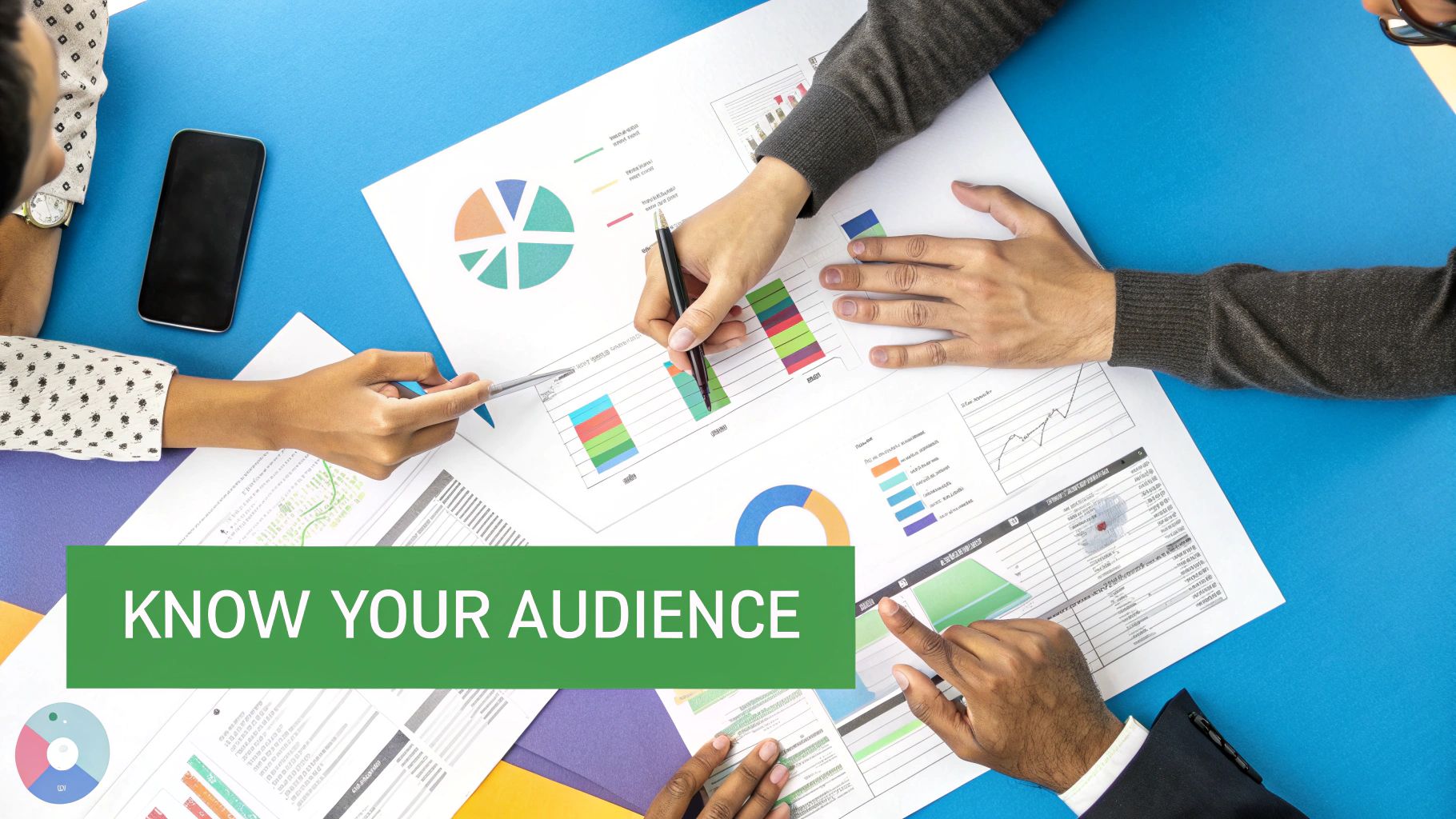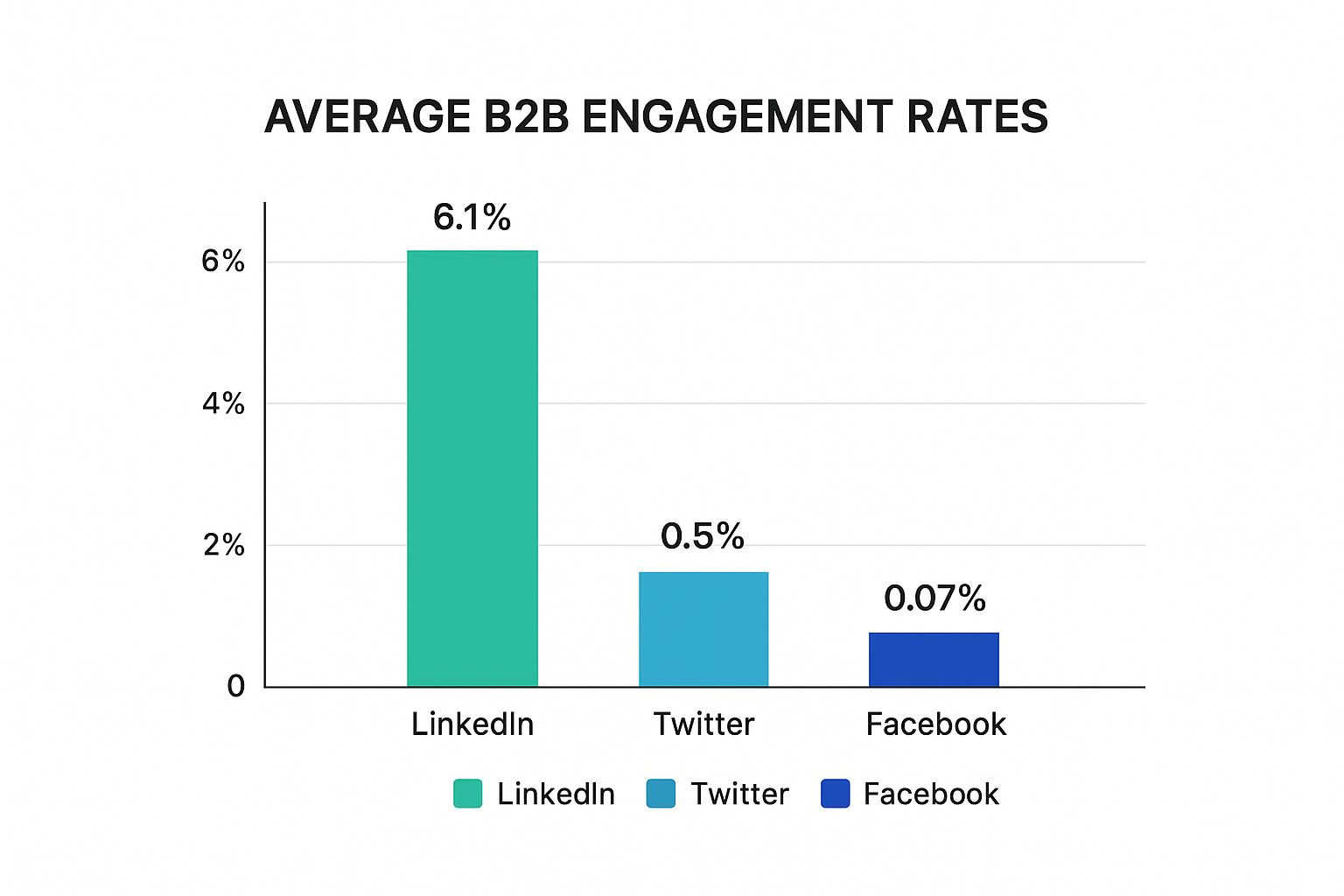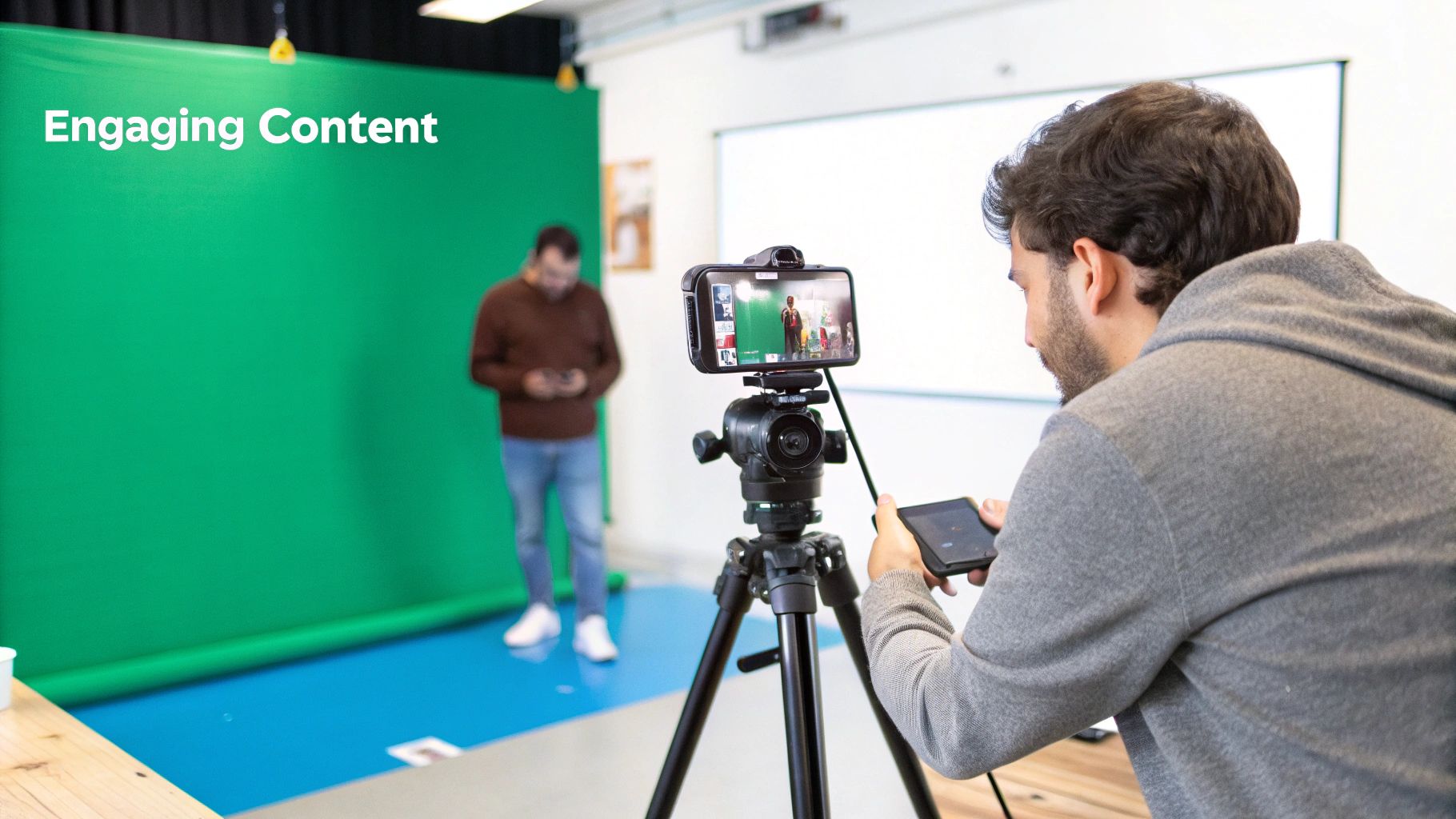A Guide to Your B2B Social Media Strategy
A modern B2B social media strategy is your playbook for turning social platforms into a genuine business driver. It’s about moving past just posting content and instead focusing on building relationships, proving your expertise, and directly feeding your sales pipeline.
Think of it as the difference between shouting into a void and having meaningful conversations with the exact people you want as customers.
Why Your B2B Social media Strategy Matters Now

Let's get one thing straight: the idea that social media is some "fluffy" extra for B2B marketing is completely outdated. The reality is, it’s become a critical battleground where business decisions get researched, validated, and shaped long before a salesperson ever gets involved.
Today's buyers don't just fill out a demo request form and wait. They're on platforms like LinkedIn, actively digging into peer reviews, sizing up thought leaders, and looking for authentic brand interactions.
Simply “being there” isn’t a strategy—it’s just adding to the noise. What separates the high-growth companies from everyone else is a purposeful, data-backed plan.
The Shift from Broadcasting to Building Relationships
Not too long ago, B2B social media felt like a digital billboard. Companies would just blast out press releases, product updates, and company news, crossing their fingers that someone, somewhere, was paying attention. That one-way communication model is fundamentally broken because it completely ignores how real people use social media.
Success today is all about genuine engagement. Your audience isn't scrolling through their feed looking for another ad. They're hunting for solutions, expertise, and partners they can actually trust.
A powerful B2B social media strategy isn't about collecting followers. It's about earning trust, showcasing value, and building a community that sees your brand as an indispensable resource.
This relationship-first approach does more than just pump up vanity metrics. It builds a rock-solid foundation of credibility that supports the entire customer journey. When you get this right, you unlock some serious benefits:
- Increased Brand Authority: When you consistently share valuable insights, you stop being just another vendor and become the expert in your field.
- Direct Access to Decision-Makers: Social media cuts through the noise, giving you a direct line to the key stakeholders you need to reach.
- Enhanced Brand Trust: Authentic conversations and transparent communication build the kind of credibility required to close complex B2B deals.
- Improved Reputation Management: Being active on social allows you to keep an ear to the ground, monitor conversations, and proactively manage your brand's image. To dive deeper, check out our guide to social media reputation monitoring.
This guide will give you a step-by-step framework to turn your social channels from a passive bulletin board into a dynamic, pipeline-building machine that delivers real, measurable business results.
How Modern B2B Buyers Use Social Media

To build a social media strategy that actually works for B2B, you first have to ditch an old, tired myth: that decision-makers aren't on social media. They absolutely are. They just use it in a completely different way than a typical consumer.
They aren’t scrolling for fun—they’re conducting deep, silent research long before they ever signal an intent to buy. Think of social media as the new digital trade show floor. They’re vetting potential partners and vendors quietly, from a distance.
A buyer might follow key employees at your company, watch how your team handles customer questions, and size up the quality of your insights. All of this happens before they even think about hopping on a sales call. This means your social presence is a massive part of the consideration phase, where your company’s expertise and culture are always on display.
The Self-Guided Research Journey
Today’s B2B buyer is overwhelmingly self-directed. They gather information on their own terms, on their own timeline, and social media is one of their primary tools for discovery. They’re there to solve problems, not to be sold to.
This research-first mindset shows up in a few key ways:
- Validating Solutions: Buyers hunt for case studies, testimonials, and real-world discussions to see if a product genuinely solves the problems they’re up against.
- Assessing Expertise: They follow industry thought leaders and company pages to get a gut check on their depth of knowledge and credibility.
- Evaluating Company Culture: They watch how a brand interacts with its community, employees, and customers to get a feel for what it would actually be like to work with them.
Most of this journey is completely invisible to sales teams until the final stages. A strong social media presence ensures you’re part of that crucial, early conversation.
The modern B2B buying process is no longer a linear funnel controlled by sales. It's a complex web of self-education where social media serves as a primary library, forum, and vetting ground—all in one.
Understanding this is everything. Your content needs to serve the researcher, not just the buyer, by offering genuine value without expecting anything in return right away.
Mobile-First and Platform-Specific Habits
The B2B research grind doesn't just happen on a desktop during office hours. Decision-makers are constantly gathering intel on their phones—during a commute, between meetings, or at home. This mobile-first reality means your content has to be optimized for a small screen and an even smaller attention span.
The data backs this up in a big way. A striking 84% of B2B buyers now use social media as a key information source in their purchasing journey, turning these platforms into a goldmine for insights. Spending follows this trend, with nearly 48% of B2B ad budgets in 2023 going straight to mobile. For B2B marketers, LinkedIn is especially powerful, generating an incredible 80% of all social media leads. You can explore more B2B marketing statistics to see the full picture.
This means your strategy has to be adaptable, meeting buyers where they are.
- On LinkedIn: This is the digital boardroom. Buyers expect in-depth articles, professional insights, and data-driven discussions to build credibility.
- On X (formerly Twitter): Here, they’re looking for real-time news, quick takes on industry trends, and direct engagement with brands and experts.
- On YouTube: They want to see solutions in action. They’re consuming product demos, tutorials, and webinar recordings to learn from the best.
Your b2b social media strategy must account for these different behaviors, tailoring content to fit the context of each platform. If you ignore this, your brand will seem out of touch and hard to engage with, effectively pulling yourself out of the buyer’s evaluation process.
Choosing the Right Social Platforms for Your Audience
Trying to be everywhere at once is a classic mistake. It stretches your team thin, dilutes your message, and pretty much guarantees you’ll get mediocre results across the board. A smart B2B social media strategy isn’t about planting your flag on every platform; it’s about showing up where your ideal customers are already talking. The goal is to focus your firepower for maximum impact.
Think of it like fishing. A pro angler doesn't just cast a giant net across the entire ocean and hope for the best. They study the fish, learn their habits, and head straight to the specific spots where they’re known to gather. Your social media presence needs that same kind of strategic precision.
LinkedIn The B2B Powerhouse
For most B2B companies, LinkedIn is the undisputed heavyweight champion. It's the only major platform built from the ground up for professional networking, which makes it an absolute goldmine for connecting with decision-makers, sharing deep industry insights, and cementing your status as a thought leader.
People on LinkedIn are in a business mindset. They're actively looking for solutions, professional development, and expert analysis. The content that wins here is educational, backed by data, and speaks directly to the challenges your audience faces. Think in-depth articles, insightful case studies, and expert takes on the latest industry trends.
LinkedIn isn't just a place to park your resume anymore. It's the digital boardroom where your brand’s expertise is on display 24/7. Success here comes from adding real value to professional conversations, not just shouting your sales pitch into the void.
While other platforms have their place, LinkedIn should almost always be the cornerstone of your B2B social media efforts. Its ad targeting is incredibly powerful, letting you zero in on specific job titles, industries, and company sizes—making it exceptionally good for generating high-quality leads.
Beyond LinkedIn Exploring Niche Opportunities
As critical as LinkedIn is, writing off other platforms means you could be leaving money on the table. The trick is to understand what makes each channel unique and match its strengths to your business goals and the people you’re trying to reach. A one-size-fits-all approach is a recipe for failure.
Just look at this chart—it shows how dramatically engagement rates can differ from one platform to another, driving home why a targeted approach is so important.

The data makes it crystal clear: LinkedIn drives way more engagement for B2B content, making it a much more efficient place to start meaningful conversations.
But don't count the others out just yet.
Facebook & Instagram: Don’t dismiss these as purely B2C playgrounds. They are fantastic for pulling back the curtain on your company culture, putting a human face on your brand with behind-the-scenes content, and connecting with your audience in a more relaxed setting. Things like sharp infographics, employee spotlights, and short video clips can perform surprisingly well here.
X (formerly Twitter): When it comes to real-time conversation, nothing beats X. It’s the perfect spot for sharing breaking industry news, jumping into live event discussions, and offering quick-response customer support. Its fast pace rewards brands that are nimble and know how to hold a conversation.
YouTube: As the world's second-biggest search engine, YouTube is an absolute beast for discoverability. It’s the ideal home for longer educational content like detailed product demos, tutorials, webinar recordings, and expert interviews that show your solutions in action.
The right mix for you depends entirely on where your audience hangs out and what kind of information they’re looking for on each channel.
B2B Social Media Platform ROI Comparison
Choosing the right platforms comes down to understanding the potential return on your investment of time and resources. While LinkedIn is the default for many, other platforms offer unique advantages that can deliver surprisingly strong results. The table below compares the major players based on marketer confidence, common use cases, and the content formats that perform best.
| Platform | Perceived ROI (Marketer Confidence) | Primary B2B Use Case | Best Content Formats |
|---|---|---|---|
| 70% of marketers have high confidence | Lead generation, thought leadership, professional networking, brand building | In-depth articles, case studies, company news, industry analysis, text & image posts | |
| 22% of marketers see highest ROI | Brand humanization, company culture, community building, targeted ads | Short videos, employee spotlights, infographics, event promotion, behind-the-scenes content | |
| 16% of marketers see highest ROI | Visual brand storytelling, employer branding, showcasing company culture | High-quality images, short videos (Reels), Stories, carousel posts, infographics | |
| YouTube | 16% of marketers see highest ROI | In-depth education, product demos, building authority, search visibility | Tutorials, webinars, expert interviews, customer testimonials, product demos |
| X (Twitter) | Varies; strong for specific industries | Real-time news, customer service, event engagement, community interaction | Quick updates, industry news, polls, threads, short video clips, links to articles |
This comparison highlights that while LinkedIn remains the top choice for direct B2B ROI, a strategic presence on platforms like Facebook and YouTube can be highly effective for different goals, such as building brand affinity or educating a wider audience.
Making Data-Informed Platform Choices
It might be surprising, but platforms other than LinkedIn can deliver a serious return. A recent global survey found that 22% of B2B marketers feel Facebook gives them the highest ROI. Instagram and YouTube weren't far behind, each getting the nod from 16% of respondents. While 70% of marketers still have high confidence in LinkedIn's ROI, these numbers prove a multi-platform strategy can pay off. This is backed up by data showing 39% of consumers head to Facebook first when they’re ready to buy something via social media. You can dig deeper into B2B social media trends and ROI to see how different channels are performing.
So how do you make the right call? Start with research. Use your buyer personas to form a hypothesis about where your audience is most active. Then, go validate it. Spend some time "listening" on those platforms. Search for relevant industry hashtags, pop into professional groups, and see where your competitors seem to be getting the most traction. Your resources are limited—put them where they’ll spark the most meaningful engagement and drive real business results.
Developing Your B2B Content Framework

Alright, you've picked your platforms. Now it's time to talk about what you're actually going to post. Your content is the engine of your entire B2B social media strategy, and it’s got one job: be ridiculously useful.
Forget shouting about your product features from the rooftops. The real goal is to become an indispensable resource for your audience. You want to solve their problems and answer their questions so consistently that you build unshakeable trust long before they even think about making a purchase.
Modern B2B buyers have zero patience for thinly veiled sales pitches. They’re looking for brands that provide authentic, educational, and genuinely helpful information. This value-first approach is what turns followers into leads. We dive deeper into this in our beginner's guide to B2B lead generation, which breaks down how great content fuels your sales pipeline.
The Power of the Content Pillar Model
Coming up with fresh, high-quality content every single day feels like running on a hamster wheel. It’s exhausting. This is where the content pillar model saves the day. Think of it as the ultimate "work smarter, not harder" system for content creation.
Instead of chasing dozens of small, disconnected ideas, you start with one massive, high-value piece of content—your "pillar." This could be a comprehensive research report, an in-depth webinar, a detailed guide, or an expert interview. This single asset then becomes the wellspring for an entire month's worth of smaller, bite-sized content tailored for each platform.
The pillar model transforms content creation from a daily scramble into a strategic, cohesive system. It ensures every piece of content you share is part of a larger, value-driven narrative, amplifying your core message and maximizing your resources.
This method lets you explore one topic from multiple angles, cementing your expertise and keeping your message consistent everywhere. It's a remarkably efficient way to completely own a specific topic in your industry.
Turning One Pillar into a Month of Content
Let’s make this real. Imagine your content pillar is a 60-minute webinar called "The Future of AI in Project Management." From that single event, you can spin off a whole universe of micro-content.
- LinkedIn Posts: Pull 5-7 key stats or powerful quotes from the webinar. Turn each one into a simple text-and-image post. You could also snip out short video clips of the best moments.
- X (Twitter) Threads: Take a meaty section, like "3 Common AI Implementation Mistakes," and break it down into an engaging, multi-post thread with clear, actionable takeaways.
- Instagram Reels/Shorts: Create snappy, 30-second videos summarizing the top three tips from your speaker. Use bold text overlays to make the key points pop for scrollers.
- Blog Post: Write a detailed recap of the webinar. Embed the full video recording and flesh out the main talking points with extra research and links.
- Infographic: Design a sharp, visually appealing graphic that summarizes the most important data points and trends discussed. This is pure gold for sharing on LinkedIn and even Pinterest.
Just like that, you've atomized one hour of content into weeks of strategic social media posts, all hammering home your expertise on a central theme.
Establishing a Consistent Brand Voice and Identity
As you push all this great content out, consistency is everything. Your brand’s voice and visual identity are the glue that holds it all together, making you instantly recognizable in a noisy feed. An inconsistent presence just confuses people and chips away at the trust you're working so hard to build.
Your brand voice is your company's personality. Are you authoritative and formal, or friendly and conversational? Witty or straight to the point? Whatever you land on, it needs to show up everywhere, from your LinkedIn articles to your replies on X.
Likewise, your visual identity—your logo, color palette, and fonts—should be unmistakable. When a prospect is scrolling, you want them to spot your content immediately, even before they’ve read a single word. That visual consistency builds brand recall and reinforces your professionalism.
Ultimately, a strong B2B content framework isn’t just about what you say, but how you say it. By marrying the efficiency of the pillar model with the trust-building power of a consistent brand identity, you create a content engine that doesn’t just attract followers—it nurtures and converts them into high-quality leads.
Executing and Measuring Your B2B Strategy
https://www.youtube.com/embed/OYbPOhPO
Having a well-researched B2B social media strategy is a great start, but it's just the map. Now it’s time to actually start the engine and drive. Execution is where your plans meet reality, turning all that thoughtful preparation into real business results through consistent action and smart measurement.
This process is more than just hitting "publish" on a few posts. It’s a coordinated effort that pulls together content scheduling, community management, and performance analysis. Think of it as operating a high-performance machine—every part has to work in sync to get you where you want to go.
Bringing Your Strategy to Life
Great execution is built on two things: consistency and engagement. To bring your content plan to life, you need solid processes and tools that streamline your workflow. This ensures your brand shows up consistently where it matters most.
Getting into a good operational rhythm frees up your team to focus on what they do best: creating high-quality content and building real relationships instead of getting buried in manual tasks.
Three things are essential for making this happen:
- Content Scheduling and Management: Use a social media management tool to plan, schedule, and publish content across all your platforms. This keeps a steady stream of valuable posts flowing and gives you more time for real-time engagement.
- Community Management: Social media is a two-way street, not a megaphone. Actively monitor comments, messages, and mentions. Responding quickly and thoughtfully shows you’re actually listening and helps build a loyal community around your brand.
- Employee Advocacy: Your own employees are your most authentic advocates. Encourage them to share company content and their own industry insights. Their networks can dramatically expand your reach and add a layer of credibility that a brand account just can't match.
Measuring What Truly Matters
Likes and follower counts feel good, but they don't pay the bills. To prove the value of your social media efforts, you have to shift your focus from vanity metrics to business metrics that tie directly to revenue and growth. This is how you show real ROI to your boss and the rest of the company.
The goal is to answer critical business questions like, "How many qualified leads did social media generate this quarter?" or "What was our cost per acquisition from our latest LinkedIn campaign?"
True social media success isn’t measured by the size of your audience, but by its impact on your sales pipeline. Track metrics that tell a financial story, connecting your activity directly to lead quality, customer acquisition, and revenue.
Start by tracking metrics across the entire marketing funnel. This approach gives you a complete picture of how your strategy is performing, from the first time someone sees your brand to the moment they become a customer.
Key Metrics for Your B2B Funnel
To measure your B2B social media strategy effectively, it helps to organize your KPIs by the stage of the buyer's journey they influence. This framework makes it easy to spot what's working and where you might need to make some tweaks.
Let's look at the essential metrics to track at each funnel stage. This table breaks down what to measure and why it's important for understanding your performance from top to bottom.
Key B2B Social Media Metrics
| Funnel Stage | Metric to Track | Why It Matters |
|---|---|---|
| Top of Funnel (Awareness) | Reach & Impressions | Shows how many unique users are seeing your content, indicating brand visibility. |
| Middle of Funnel (Consideration) | Website Clicks & Engagement Rate | Measures how many users are taking the next step and how compelling your content is. |
| Bottom of Funnel (Conversion) | Cost Per Lead (CPL) & Conversion Rate | Tracks the efficiency of your lead generation efforts and how many leads become customers. |
By tracking these, you get a much clearer, more actionable view of your social media's impact on the business. It helps you move beyond surface-level numbers and focus on what's driving actual growth.
The Role of Paid Social Advertising
Organic reach is important, but paid social advertising is a powerful accelerator. It allows you to target your ideal customer profile with surgical precision, ensuring your best content gets in front of the right decision-makers at exactly the right time.
Global social media ad spend is set to exceed $256 billion, which signals a major shift: B2B marketers are now treating these platforms as core revenue drivers. For instance, 70% of B2B marketers confirm that LinkedIn delivers a positive ROI. The most effective content for this? Short-form video, which 35% of marketers say provides the highest ROI. You can discover more insights about B2B social media trends on intentsify.io.
When you combine a solid execution plan with rigorous, business-focused measurement, you transform your social media presence from a simple communication channel into a predictable, scalable engine for growth.
Frequently Asked Questions About B2B Social Media
Even the best B2B social media strategy raises a few questions. Let's tackle some of the most common challenges marketers run into, with direct answers to help you sharpen your approach and prove its value.
How Much Should a B2B Company Budget for Social Media?
There’s no single magic number, but a smart starting point is 10-20% of your total marketing budget. This chunk should cover everything from organic efforts (like content creation and management tools) to paid advertising.
The ideal split really depends on your goals. If your main objective is building brand awareness, you’ll probably invest more in creating high-quality, authoritative content. But if you're focused on direct lead generation, a bigger slice of that budget needs to go toward targeted ads on platforms like LinkedIn.
Take a look at what your competitors are doing, use the ad estimators on the platforms themselves to get a baseline, and then get ready to optimize based on your own real-world performance.
What Are the Most Common Mistakes to Avoid?
It's funny, but most B2B companies stumble over the same few hurdles on social media. Just avoiding these common mistakes will put you way ahead of the curve and make sure your efforts actually pay off.
Here are the big ones to watch out for:
- Being Too Promotional: Your content should provide value first and sell second. Nobody wants to follow a walking billboard. Constantly pushing products is a surefire way to drive potential customers away.
- Ignoring Community Engagement: Social media is a two-way street. When you fail to respond to comments and messages, your brand just seems disconnected and aloof. It's a conversation, not a broadcast.
- Using a One-Size-Fits-All Approach: Blasting the exact same message across every platform is lazy and ineffective. It ignores the unique audience and context of each network.
- Obsessing Over Vanity Metrics: Follower counts and likes feel good, but they don't pay the bills. These numbers don't mean much without a clear connection to real business goals like website traffic and qualified leads.
- Inconsistent Posting: Sporadic activity is a killer. It hurts both your audience's interest and your reach in the algorithm. You have to show up consistently.
How Can I Prove the ROI of My B2B Social Media?
Proving ROI is all about connecting the dots between your social media activity and tangible business outcomes. The key is to look past surface-level metrics and track the entire customer journey, from a social post all the way to a closed deal.
The most effective way to demonstrate ROI is to show how social media directly contributes to the sales pipeline. This means tracking leads, conversions, and the revenue influenced by your social channels.
Start by using UTM parameters on every single link you share. This is non-negotiable. It allows you to track website traffic and conversions directly inside your analytics platform, so you know exactly where people are coming from.
Next, integrate your social channels with your CRM. This is where the magic happens. It lets you follow leads through the entire sales funnel, measuring crucial metrics like Cost Per Lead (CPL) and your Lead-to-Customer Conversion Rate. This data gives you the hard financial proof you need to justify your strategy, showing that social media isn’t just a branding exercise—it's a vital part of a modern B2B growth engine. This is especially important now, as we covered in our article on why cold outreach doesn't work anymore.
Ready to stop guessing and start finding high-intent leads on social media? Intently uses AI to monitor conversations on Reddit, X, and LinkedIn, delivering qualified prospects directly to you. Discover your next customer with Intently today.
